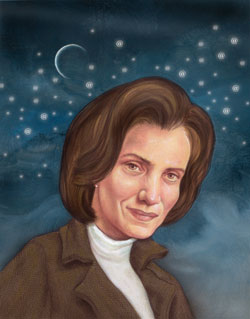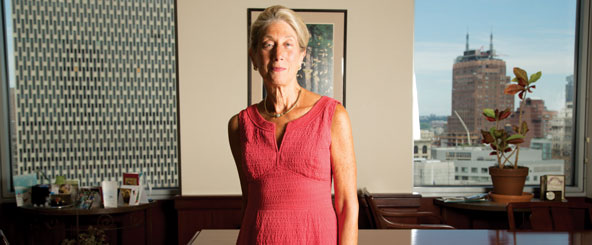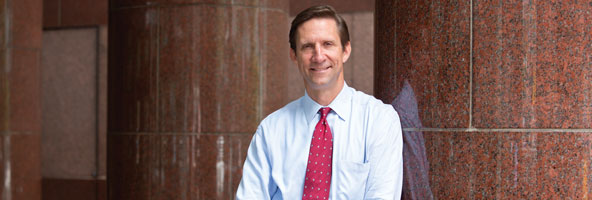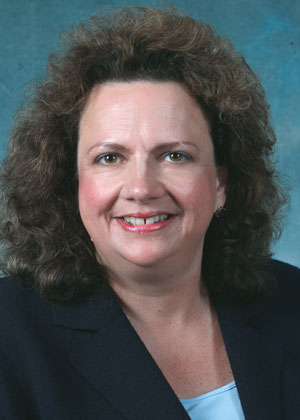Looking back on Zubulake, 10 years later

Portrait of Laura Zubulake by Anita Kunz
When Laura Zubulake first brought her employment discrimination lawsuit to attorney James Batson in 2001, neither of them thought the case would make history. Neither did U.S. District Judge Shira Scheindlin, who presided over the case in the Southern District of New York.
In fact, Scheindlin has mentioned many times that Zubulake’s lawsuit seemed like a “garden-variety employment discrimination case.” Zubulake didn’t get a promotion she thought she had earned at the global financial services firm UBS Warburg, filed a complaint with human resources and suddenly found herself at odds with her bosses. It’s a fact pattern that could describe hundreds, or even thousands, of employment discrimination lawsuits currently pending throughout the United States.
Turns out, they couldn’t have been more wrong.
It’s been 10 years since Scheindlin issued a pivotal pretrial ruling in Zubulake v. UBS Warburg that continues to reverberate today. That 2004 ruling, nicknamed Zubulake V because it was the fifth of five pretrial decisions, became a landmark in many respects. It helped propel the e-discovery industry into the stratosphere, turning it into one worth billions, while setting up litigation rules that are still being fought over 10 years later.
That decision changed the way companies and lawyers approach electronically stored information. Companies were put on notice that they had a duty to preserve data once they reasonably anticipated they might be sued. As for lawyers, it wasn’t enough for them to simply initiate the hold. Instead, lawyers now had an obligation to oversee the compliance process. Otherwise, the consequences could be severe and a party could be hit with sanctions that, in some cases, could cripple its ability to mount a defense.
The tip-off for Zubulake’s attorneys that they weren’t getting all the electronic evidence available from UBS came as they were preparing to conduct depositions. Batson, then a partner with Liddle & Robinson in New York City, recalls being surprised that the Swiss-based firm produced only 120 emails in response to Zubulake’s document request.
“That’s when we knew something was wrong,” Batson says. “How could UBS, [within] a highly regulated industry, have so few emails?”
It also helped that Zubulake understood the value of preserving information. On her own, she had printed out more than 400 emails that were relevant to her complaint, and this disparity helped convince her lawyers that UBS was holding back.
“I was accustomed to having access to timely information, which is important to have because the markets are always moving,” says Zubulake, who now divides her time between speaking or writing about her experiences and selling real estate in the Hamptons for Sotheby’s International Realty. “I also understood Wall Street. It’s always good to keep records, especially when it comes time for your year-end review.”
Zubulake says she pushed Batson and her legal team to search for the emails, even as UBS claimed they didn’t exist. “I understood how the information was created,” Zubulake says. “I believed it was somewhere. We just had to find it.”
Zubulake was comfortable with technology and had been using email and other forms of electronic communication for years. “Wall Street is quick to adapt to new technology,” says Zubulake. “In the late ’80s and early ’90s, we were already migrating from paper to electronic means of communication.”

Photo of Shira Scheindlin by Arnold Adler
A FIGHT OVER COST
As the discovery phase dragged on, UBS revealed that its data was contained on backup tapes, but the company resisted extracting it by claiming the cost (more than $300,000) would be too high. Batson says he doubted it would cost that much and exchanged letters with UBS’ attorneys demanding the documents from the backup tapes. The company’s lead attorney on the suit, Kevin Leblang of Kramer Levin Naftalis & Frankel, did not respond to requests for comment.
Batson says he realized that this was not going to be a routine discovery dispute when he received a letter from the magistrate judge overseeing the discovery process informing him that the dispute would be heard by Scheindlin.
“We thought that was odd,” Batson says. “Why would the magistrate judge refer a discovery dispute back to the district judge? But then we did research on her and found she had written an article for the Boston College Law Review on e-discovery. We thought to ourselves: ‘This might get interesting.’ “
Indeed, the subject of e-discovery had been on Scheindlin’s mind for several years. That law review article, which she co-authored in 2000 with a former clerk, Jeffrey Rabkin, was titled “Electronic Discovery in Federal Civil Litigation: Is Rule 34 Up to the Task?” (Rabkin is currently the special assistant attorney general for law and technology in the California attorney general’s office.)
While Zubulake was pending before Scheindlin, the judge also served on the advisory committee for the Federal Rules of Civil Procedure as it was considering amendments to cover e-discovery for the first time. (The amendments were formally adopted in 2006.) Scheindlin says the case gave her a chance to write about issues that interested her and were starting to come to the forefront of litigation.
“There had been a few decisions in this area, but not a lot,” she says. E-discovery “was wide open.”
In light of the lack of precedent, Scheindlin says she did not want to hold either side to too high a standard. Additionally, she wanted to provide a road map for others to begin following. Her main objective was to spell out when a party’s duty to preserve data began and what remedies were available to an aggrieved party if evidence had been lost.
The first three Zubulake decisions dealt mainly with costs and whether or not UBS could force Zubulake to pay for extracting data from the backup tapes. With Zubulake IV, however, it was clear that some of the data was unrecoverable, and Scheindlin had to decide how to proceed. She declined to impose an “adverse inference” sanction against UBS, whereby a jury would be instructed that any evidence UBS failed to provide would have been beneficial to Zubulake.
“In practice, an adverse inference instruction often ends litigation—it is too difficult a hurdle for the spoliator to overcome,” Scheindlin wrote in Zubulake IV in 2003.
THE HAMMER FALLS
By the time Zubulake V rolled around, Scheindlin was no longer in an accommodating mood. During additional depositions that came about as a result of Zubulake IV, Zubulake’s lawyers found there were even more emails and documents that UBS had either deleted or failed to preserve.
This time Scheindlin granted Batson’s motion for an adverse inference, finding that “UBS failed to preserve relevant emails, even after receiving adequate warnings from counsel, resulting in the production of some relevant emails almost two years after they were initially requested, and resulting in the complete destruction of others.”
Zubulake won a $29.2 million verdict from the jury in 2005 and ultimately chose to settle with UBS before the case could be heard by an appellate court.
It’s easy to overstate the role the adverse inference sanction played in Zubulake V. In fact, Batson and his co-counsel and fellow partner at Liddle & Robinson, James Hubbard, say adverse inference didn’t actually play a huge role in Zubulake’s victory.
Instead, Batson points to what Scheindlin refers to in that opinion as a “self-executing sanction.” Because UBS resisted producing or failed to preserve the requested documents, UBS’ lawyers were unable to prepare their witnesses properly before being deposed. As such, Batson and Hubbard caught them in many inconsistencies. For instance, Michael Davies—UBS head of human resources—had claimed in his deposition that an email exchange between him and another executive, Brad Orgill, in which they sought to “exit her by the end of the month,” had taken place before they knew about Zubulake’s discrimination claim. When the complete email exchange was finally turned over, it showed that Davies had already known about the complaint.
“It put the lie to his earlier testimony,” says Batson, who is currently an investment manager at the litigation-funding company Bentham IMF. “They should have just restored every single backup tape so that they would know what their evidence was. Instead, they kept looking worse and worse as the case went on.”
Hubbard recalls the jurors were asked what was the most important factor that caused them to rule for Zubulake. “The jurors weren’t concerned about the stuff the lawyers were fighting about,” says Hubbard, who is still a partner at Liddle & Robinson. “Instead, they were swayed by the evidence we presented of how [UBS] treated Laura. They said that the adverse inference didn’t really drive the train.”

Photo of James Batson by Arnold Adler.
A NEW INDUSTRY
What’s not easy to overstate is Zubulake’s impact on the e-discovery industry. While there were other individuals and companies working in the e-discovery space before Zubulake, several of these people acknowledged the impact Scheindlin’s opinions had on their field.
Litigator Michael Arkfeld was already writing about e-discovery and published his treatise Arkfeld on Electronic Discovery and Evidence in 2003. He calls Scheindlin’s opinions ground-breaking, and marvels over how much of her rulings continue to be influential after a decade.
“It’s very unusual to have a judge set the tone like that and set it for so many years,” says Arkfeld, who remembers that he was pleased to see his treatise cited in one of her opinions.
Arkfeld says the field of e-discovery was almost nonexistent before Zubulake and the 2006 amendments to the Federal Rules of Civil Procedure. There were very few e-discovery vendors and a small handful of people who were even thinking about the issue.
“There was only one vendor I was aware of at the time—John Jessen [founder of Electronic Evidence Discovery, now known as Daticon EED] from New York,” Arkfeld says. “I’d go to his office and there would be hundreds, if not thousands, of software boxes stacked on top of each other because, in those days, you had to have the original software if you wanted to run a program.”
Catalyst CEO John Tredennick is another e-discovery vendor who was active prior to the Zubulake decisions. For him, Zubulake and the 2006 rules were a one-two punch that not only expanded the e-discovery industry but also reframed its focus.
“Back in the day there were a few providers out there, but the focus was heavily on images—namely which was better, TIFF files or PDF files,” says Tredennick, formerly a litigation partner at Holland & Hart who created Catalyst when he spun off his e-discovery group from the firm in 2000. “There wasn’t much emphasis on emails.”
According to Tredennick, Zubulake changed that by imposing a far-reaching duty to preserve on every corporation in the country, as well as any company in the world with a connection to the U.S.
“Up until that opinion, the rules of the game for preserving docs were simple and clear,” Tredennick says. “When the other side was interested in getting a document, they’d send over a request for it and, putting aside objections, that’s when the duty attached. Scheindlin came along and said no more. She changed the rule—and in doing so, she created an industry, as well as a drastic mess for corporate America.”
Litigator George Socha and IT consultant Tom Gelbmann were compiling the Electronic Discovery Reference Model while Zubulake was pending before Scheindlin. The EDRM formally launched in May 2005; however, Socha says and he and Gelbmann started laying the groundwork for it in 2003, when they issued their first e-discovery report. They found that there was little to no consensus among lawyers and e-discovery vendors as to what constituted e-discovery and what best practices lawyers should follow in dealing with it.
“We didn’t see anyone taking those questions on,” says Socha. “We approached a few groups but no one was interested, so finally we decided to do it ourselves. We figured we’d get a few people to join us, if we were lucky.”
Socha notes that interest in e-discovery began to explode even before Scheindlin handed down Zubulake V. “By the time we had Zubulake III, it was pretty clear that something very significant was going on,” he says. “Once we got that decision, folks started trying to gin up e-discovery business and were definitely trying to ride on the back of those decisions.”

Photo of Martha Dawson courtesy of the subject
NO TURNING BACK
Even though the EDRM was a separate effort from Zubulake and focused more on what e-discovery entails, Socha says the decisions led to increased attention for the work he and Gelbmann were doing.
“Because of her decision, people realized they needed to figure out what e-discovery was,” Socha says. “Lawyers knew that if they had to appear in front of her on an e-discovery matter, they couldn’t go in cold. That meant folks were trying to find more in the way of e-discovery reference materials.”
It also meant that more law firms would start following the lead of Martha Dawson, a litigation partner at what was then known as Preston Gates & Ellis (now part of K&L Gates). In 1997, after combing through a massive trove of emails in high-profile lawsuits involving Exxon and Microsoft, she convinced her firm to set up a full-time e-discovery practice group.
The e-DAT group (e-Discovery Analysis & Technology) is widely considered to be the first of its kind at a major law firm. Since then, 87 of the firms listed on the Am Law 200 have set up e-discovery practice groups, according to a 2010 survey by the Cowen Group.
“I saw my clients and firm embrace email and electronic and collaborative tools to conduct business,” Dawson says. “Starting from 1995, there were more tools available that allowed us to do things more efficiently. It seemed natural that the world would move toward that.”
Dawson praises Zubulake for being well-written and providing clear guidance to lawyers and companies throughout the country. “Scheindlin said that the opinion would only be good in her jurisdiction, but it has become so influential,” Dawson says. “At that point, most of us were operating in a vacuum, which is extremely difficult. It was very helpful to have those opinions tell us what our duties are.”
The case also continues to loom large in Laura Zubulake’s life. She more or less has automatic invites to all of the major e-discovery conferences, and when she chooses to attend, she is treated like a rock star.
“The minute people hear my name, they know who I am,” Zubulake says. “It’s been nice, though. So many people have thanked me for helping to create their careers. A lot of attorneys express appreciation for my efforts to help set standards.”
Besides e-discovery conferences, she maintains her own website and has published a book, Zubulake’s e-Discovery: The Untold Story of My Quest for Justice.
She also is a frequent lecturer and conducts e-discovery training sessions for the U.S. Department of Justice. In August, she delivered the keynote address at the American Health Information Management Association’s Clinical Documentation Improvement summit in Washington, D.C.
“The Zubulake decision is still very relevant today, and the health care industry is the next big industry that will be facing the transformation from paper to electronic records,” she says.
But not everyone treats her like a hero. For many corporations, she—along with Judge Scheindlin—is the reason they have to spend so much time and money preserving data.
“Some people have expressed resentment toward me,” Zubulake says. “But they’ll usually just smile and admit that it was inevitable. If it hadn’t been my case, it would have been someone else’s.”
CHANGES COMING
Dawson notes that Scheindlin’s rulings remain influential, pointing out that Zubulake V has been cited in more than 180 cases listed on Westlaw, including a California ethics opinion in June. But the Zubulake rulings might not be the gold standard for much longer.
In early June, after much debate and deliberation, the Judicial Conference’s Committee on Rules of Practice and Procedure finally approved amendments to the Federal Rules of Civil Procedure relating to the scope of e-discovery and what happens when a party fails to preserve evidence. The next step is a final review of the rules in September before the U.S. Supreme Court steps in and looks at the changes.
One proposal, Rule 26(b)(1), covers proportionality and seeks to strike a balance between defendants’ complaints about having to preserve too much data and plaintiffs’ worries about losing access to electronically stored information. The new rules maintain that the scope of e-discovery should be limited to prevent endless fishing expeditions, and encourage attorneys and judges to work together and communicate more so as to come up with ways to limit e-discovery without depriving one side of its rights.
Scheindlin has said that she is concerned the new rule is designed to limit discovery, and that lawyers might spend more time fighting over whether or not documents are discoverable instead of working together to make sure the process goes smoothly. “The current definition of scope has been working well,” Scheindlin says. “Most studies show that in the vast majority of cases, lawyers and judges believe the amount of discovery taken is just right.”
Another proposal, Rule 37(e), gives judges a wide amount of discretion over imposing a range of sanctions for lost e-discovery. Under the proposed rule, sanctions are appropriate anytime e-discovery “that should have been preserved in the anticipation or conduct of litigation is lost because a party failed to take reasonable steps to preserve it.”
However, the new rules explicitly limit a judge’s ability to impose the adverse inference sanction. In Zubulake and subsequent opinions, Scheindlin had held that a party could be hit with the adverse inference if it was behaving purposefully, recklessly or negligently. The new rule, however, only allows the adverse inference when a party acts with the intent to deprive another party of the information’s use in the litigation.” Scheindlin calls the new rule “workable” but notes that it fails to promote a uniform standard. “Corporate America was upset about over-preserving everything,” Scheindlin says. “Meanwhile, some judges had different criteria for imposing sanctions. People wanted a uniform national standard. They didn’t quite get that here.”
Scheindlin also predicts there will be litigation over what “reasonable steps” to preserve data will entail, pointing out that it’s never been defined.
“Maybe I’ll get to write about it,” she says.
This article originally appeared in the September 2014 issue of the ABA Journal with this headline: “Zubulake 10 Years After: Landmark case created an industry–and still stirs debate.”
Sidebar
5 key e-discovery cases
Zubulake may have been a groundbreaking case in the e-discovery realm, but it’s hardly the only one. In the years since Judge Shira Scheindlin handed down her landmark decision, several other cases have joined it in annals of history. Like Zubulake, some of these cases broke new ground and dealt with technologies and methods that were foreign concepts to many attorneys.
Victor Stanley Inc. v. Creative Pipe Inc.
U.S. District Court, District of Maryland
May 2008
Victor Stanley sued Creative Pipe for copyright and patent infringement over the design of an end frame for a park bench. U.S. Magistrate Judge Paul Grimm ruled Creative Pipe had waived attorney-client privilege when it inadvertently produced several electronic documents. Grimm found Creative Pipe waived the privilege because it had failed to work out a privilege search protocol with the opposition, it had declined to use a “clawback” agreement, and it had not proven that its search process for privileged documents was reasonable. As such, Grimm deemed the documents to have been voluntarily disclosed. Victor Stanley prevailed at trial in September 2011, winning more than $2 million in damages and more than $1 million in a monetary sanction against Creative Pipe for destroying electronic evidence. The verdict was upheld on appeal in February 2013.
Mancia v. Mayflower Textile Services Co.
U.S. District Court, District of Maryland
October 2008
Once again, Grimm made his mark in e-discovery in this wage-and-hour case brought by several Mayflower employees. Grimm held that the failure of opposing counsel to cooperate and work out disputes on their own was the biggest reason why e-discovery costs were skyrocketing. He strongly advised counsel from both sides to work together and make the e-discovery phase move more smoothly. The parties settled in November 2009. Many judges have followed Grimm by advising attorneys before them to cooperate and hold regular conferences before even setting foot into court. The proposed e-discovery amendments to the Federal Rules of Civil Procedure also contain a duty to cooperate.
The Pension Committee of the University of Montreal Pension Plan, et al. v. Banc of America Securities
U.S. District Court, Southern District of New York
January 2010
Judge Scheindlin dealt with the question of spoliation of electronic evidence and found herself reiterating many of the points she had made in Zubulake. (She even called the case “Zubulake Revisited: Six Years Later.”) Investors in the pension plan had filed suit to recover lost funds. Several investors were accused of failing to preserve evidence, and Scheindlin focused heavily on the duties of counsel. She ruled that attorneys were obligated to issue written litigation holds in order to preserve electronic and paper records, and that failure to do so would be considered gross negligence. Scheindlin also reinforced the idea that sanctions should be mild, but that parties behaving recklessly, negligently and knowingly could be sanctioned, depending on the level of harm experienced by the other party. In this case, Scheindlin handed down monetary sanctions and the dreaded adverse inference. The parties eventually settled out of court.
Rimkus Consulting Group Inc. v. Cammarata
U.S. District Court, Southern District of Texas
February 2010
One month after Pension Committee, U.S. District Judge Lee Rosenthal refused to follow Scheindlin’s jurisprudence in a case where a consulting group was trying to enforce a noncompete agreement with a group of former employees. Rimkus accused its ex-employees of intentionally deleting relevant emails and asked for sanctions. Rosenthal ruled sanctions were only appropriate in instances like this where a party behaves in bad faith. Rosenthal’s opinion also highlighted a major split among federal circuits as to when sanctions were appropriate—a split that could only be resolved by the U.S. Supreme Court or the proposed new federal rules. In June 2010, the case was resolved when Rosenthal imposed a permanent injunction preventing the ex-employees from using certain facts and methods they had obtained while working at Rimkus.
Da Silva Moore v. Publicis Groupe & MSL Group
U.S. District Court, Southern District of New York
February 2012
U.S. Magistrate Judge Andrew Peck approved protocols to allow for both sides to use predictive coding in conducting e-discovery. The decision—believed to be the first to endorse the use of technology-assisted review—clearly states that “while some lawyers still consider manual review to be the ‘gold standard,’ that is a myth, as statistics clearly show that computerized searches are at least as accurate, if not more so, than manual review.” However, the case, which remains open, got bogged down as attorneys representing Da Silva Moore filed a petition for Peck to recuse himself from the case, accusing him of being biased as a result of his previous public comments in favor of using predictive coding. The appellate courts backed Peck, and the U.S. Supreme Court declined to intervene in October 2013.



